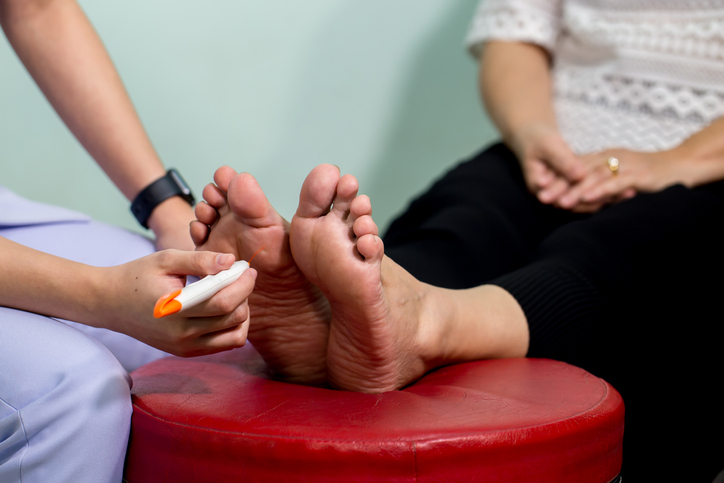Pain
5 Frequent Causes of Foot and Leg Pain

Foot pain
The foot is made up of 26 bones that are connected by joints, muscles, tendons and ligaments. Since the foot carries all the body’s weight, it is susceptible to injuries and stress. Limited mobility can result from pain, inflammation or injury.
Leg pain
Leg pain can affect the entire leg or a specific area, such as the knee, shin or thigh. Mild leg pain can be intermittent and sore after certain activities, while severe pain can limit weight-bearing or physical activities. Pain can be caused by wear and tear, overuse, or injuries to the joints, bones, muscles, tendons or ligaments.
Frequent causes of foot and leg pain
Although foot and leg pain may be caused by a variety of conditions, there are five leading causes. They include lumbar degenerative disc disease, herniated disc, spinal stenosis, spondylolisthesis, and sciatica.
Lumbar Degenerative Disc Disease

Degenerative disc disease (DDD) is a condition of the spine, in which one or more of the discs between the vertebrae, also known as intervertebral discs, cause neck or back pain. Intervertebral discs are the cushions between the vertebrae; they keep the back pliable and enable the body to bend, twist, and carry weight. Intervertebral discs are mainly composed of water. As a person naturally ages, the discs dry out, losing their flexibility, elasticity, and the ability to absorb shock. When this causes pain, it is referred to as degenerative disc disease.
Symptoms of lumbar degenerative disc disease include leg and lower back pain.
Referred pain presents as a dull, achy, or all-over pain in the legs and feet. A condition known as foraminal stenosis occurs if the nerve root becomes compressed, in which the disc degenerates, moves and shrinks. This leaves little room for the nerve root, resulting in shooting or electric pain.
Lumbar Herniated Disc

A herniated disc (or disk) is also referred to as a slipped or ruptured disc. Spinal discs are rubbery cushions that sit between individual vertebrae. As a disc naturally degenerates with age, the soft jelly-like center of the disc (nucleus) can herniate or tear through the tougher, rubbery exterior (annulus). This can occur at any point of the spine, but the most common location is between the fourth and fifth lumbar vertebrae in the lower back.
The symptoms of a herniated disc vary, depending on the exact location of the herniation. A lumbar herniated disc places pressure on an area under the nerve root, causing pain that radiates down the leg and into the foot.
Lumbar Spinal Stenosis

Spinal stenosis is a narrowing of the spinal canal. It occurs when the bony openings within the spine (foramina) begin to narrow, placing pressure on the nerves traveling throughout the spine. This reduced nerve space can occur within the spinal cord or where the spinal nerves exit the spinal canal.
The spine (backbone) runs from the neck to the lower back. The bones of the spine (vertebrae) form the spinal canal, which houses the spinal cord and nerves. If a spinal nerve or the spinal cord becomes compressed, pain, numbness, muscle weakness, or tingling may occur. Spinal stenosis most often occurs in the lower back (lumbar stenosis) or neck (cervical stenosis). Spinal stenosis of the upper/middle back (thoracic stenosis) is rare.
Spondylolisthesis

Spondylolisthesis is a medical condition that primarily affects the lower back (lumbar spine); however, it can also occur in the mid to upper back (thoracic spine) or neck (cervical spine). The body has 33 stacked vertebrae that form the foundation of the spine. Spondylolisthesis occurs when a vertebra slips forward (anterolisthesis) or backward (retrolisthesis) onto the vertebra underneath it, which may lead to nerve compression.
A pinched or compressed nerve can lead to severe leg pain. Symptoms may present as muscle spasms, pain or tightness in the legs or buttocks (especially when standing), and numbness, weakness or tingling in the legs (if nerves are compressed).
Sciatica

Sciatica, or sciatic nerve pain, refers to pain that occurs when the sciatic nerve root in the lower back becomes compressed, irritated or inflamed. Sciatic nerve pain radiates from the lower back, into the buttocks, and down the legs. It is most commonly the result of a herniated or slipped disc, bone spurs, or spinal stenosis.
The type of sciatica is dependent upon one or both legs being affected and the duration of symptoms. Sciatica types include acute, chronic, alternating and bilateral. It is typically experienced as a shooting pain.











